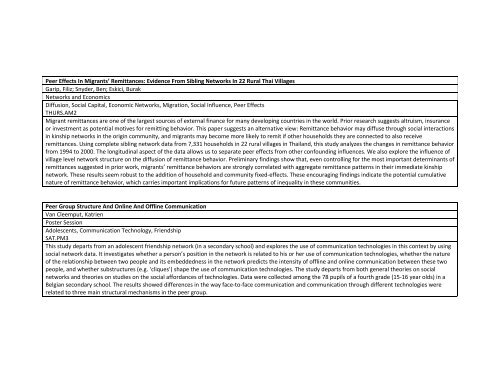Sunbelt XXXI International Network for Social Network ... - INSNA
Sunbelt XXXI International Network for Social Network ... - INSNA
Sunbelt XXXI International Network for Social Network ... - INSNA
Create successful ePaper yourself
Turn your PDF publications into a flip-book with our unique Google optimized e-Paper software.
Peer Effects In Migrants’ Remittances: Evidence From Sibling <strong>Network</strong>s In 22 Rural Thai VillagesGarip, Filiz; Snyder, Ben; Eskici, Burak<strong>Network</strong>s and EconomicsDiffusion, <strong>Social</strong> Capital, Economic <strong>Network</strong>s, Migration, <strong>Social</strong> Influence, Peer EffectsTHURS.AM2Migrant remittances are one of the largest sources of external finance <strong>for</strong> many developing countries in the world. Prior research suggests altruism, insuranceor investment as potential motives <strong>for</strong> remitting behavior. This paper suggests an alternative view: Remittance behavior may diffuse through social interactionsin kinship networks in the origin community, and migrants may become more likely to remit if other households they are connected to also receiveremittances. Using complete sibling network data from 7,331 households in 22 rural villages in Thailand, this study analyzes the changes in remittance behaviorfrom 1994 to 2000. The longitudinal aspect of the data allows us to separate peer effects from other confounding influences. We also explore the influence ofvillage level network structure on the diffusion of remittance behavior. Preliminary findings show that, even controlling <strong>for</strong> the most important determinants ofremittances suggested in prior work, migrants’ remittance behaviors are strongly correlated with aggregate remittance patterns in their immediate kinshipnetwork. These results seem robust to the addition of household and community fixed‐effects. These encouraging findings indicate the potential cumulativenature of remittance behavior, which carries important implications <strong>for</strong> future patterns of inequality in these communities.Peer Group Structure And Online And Offline CommunicationVan Cleemput, KatrienPoster SessionAdolescents, Communication Technology, FriendshipSAT.PM3This study departs from an adolescent friendship network (in a secondary school) and explores the use of communication technologies in this context by usingsocial network data. It investigates whether a person’s position in the network is related to his or her use of communication technologies, whether the natureof the relationship between two people and its embeddedness in the network predicts the intensity of offline and online communication between these twopeople, and whether substructures (e.g. ‘cliques’) shape the use of communication technologies. The study departs from both general theories on socialnetworks and theories on studies on the social af<strong>for</strong>dances of technologies. Data were collected among the 78 pupils of a fourth grade (15‐16 year olds) in aBelgian secondary school. The results showed differences in the way face‐to‐face communication and communication through different technologies wererelated to three main structural mechanisms in the peer group.
















